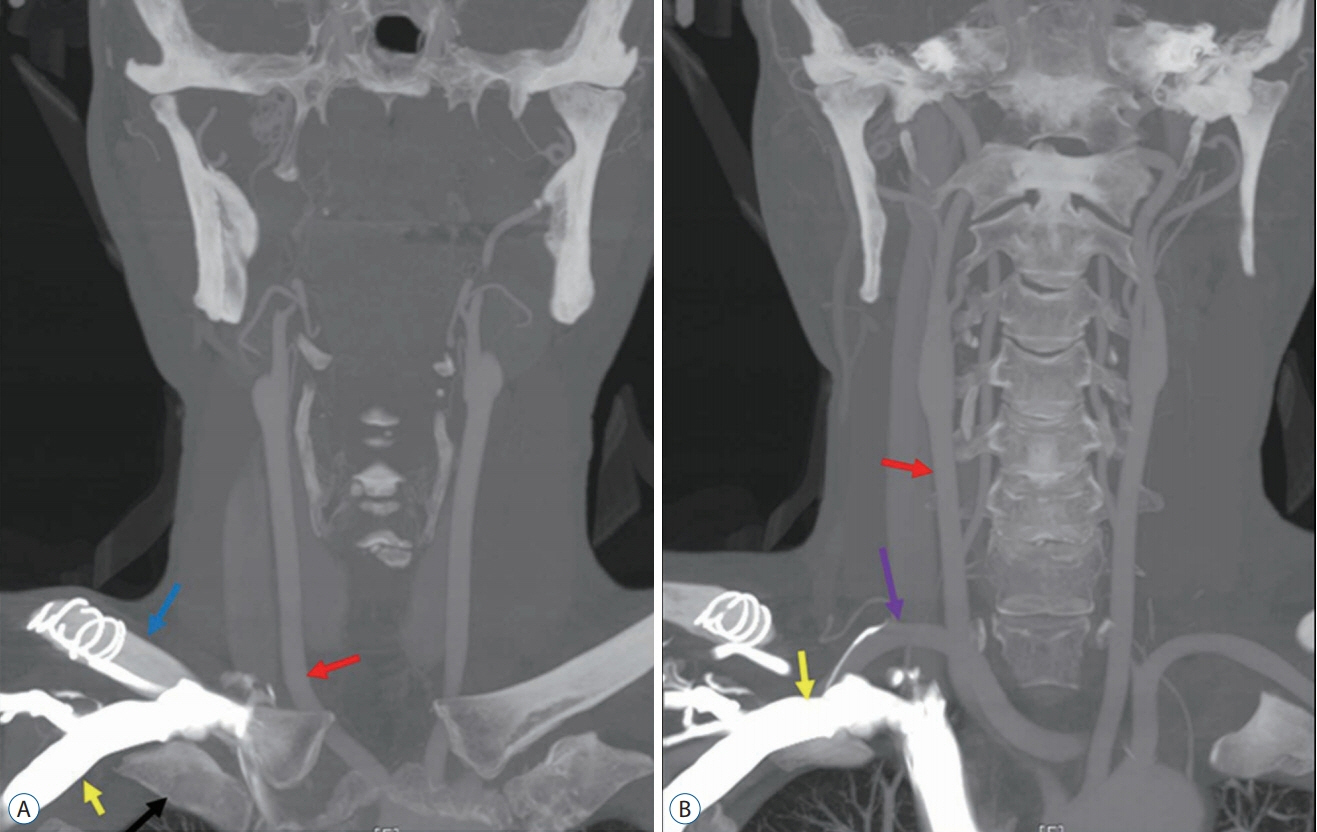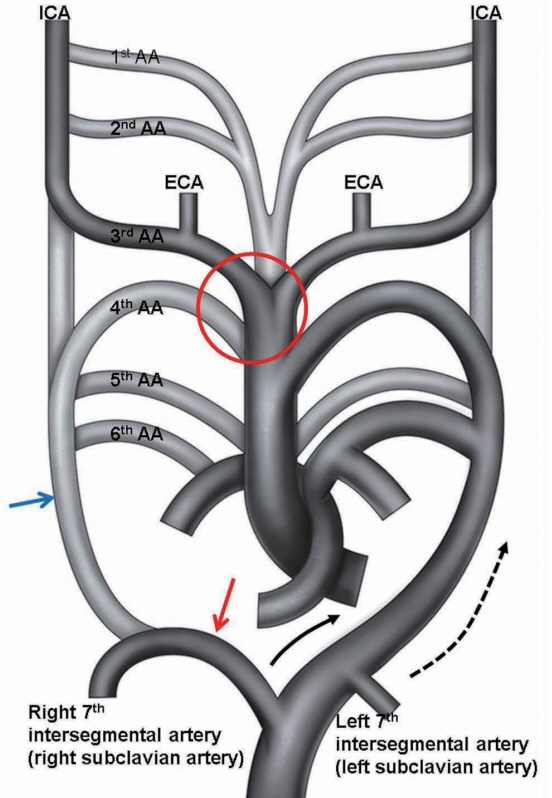J Korean Neurosurg Soc.
2019 Mar;62(2):175-182. 10.3340/jkns.2018.0048.
Prevalence and Anatomy of Aberrant Right Subclavian Artery Evaluated by Computed Tomographic Angiography at a Single Institution in Korea
- Affiliations
-
- 1Department of Neurosurgery, National Medical Center, Seoul, Korea. hanibalkms@hanmail.net
- 2Brain Center, Pohang SM Christianity Hospital, Pohang, Korea.
- KMID: 2441561
- DOI: http://doi.org/10.3340/jkns.2018.0048
Abstract
OBJECTIVE
Aberrant right subclavian artery (ARSA) is a rare anatomical variant of the origin of the right subclavian artery. ARSA is defined as the right subclavian artery originating as the final branch of the aortic arch. The purpose of this study is to determine the prevalence and the anatomy of ARSA evaluated with computed tomography (CT) angiography.
METHODS
CT angiography was performed in 3460 patients between March 1, 2014 and November 30, 2015 and the results were analyzed. The origin of the ARSA, course of the vessel, possible inadvertent ARSA puncture site during subclavian vein catheterization, Kommerell diverticula, and associated vascular anomalies were evaluated. We used the literature to review the clinical importance of ARSA.
RESULTS
Seventeen in 3460 patients had ARSA. All ARSAs in 17 patients originated from the posterior aspect of the aortic arch and traveled along a retroesophageal course to the right thoracic outlet. All 17 ARSAs were located in the anterior portion from first to fourth thoracic vertebral bodies and were located near the right subclavian vein at the medial third of the clavicle. Only one of 17 patients presented with dysphagia.
CONCLUSION
It is important to be aware ARSA before surgical approaches to upper thoracic vertebrae in order to avoid complications and effect proper treatment. In patients with a known ARSA, a right transradial approach for aortography or cerebral angiography should be changed to a left radial artery or transfemoral approach.
MeSH Terms
Figure
Cited by 1 articles
-
Single Centre Experience on Decision Making for Mechanical Thrombectomy Based on Single-Phase CT Angiography by Including NCCT and Maximum Intensity Projection Images – A Comparison with Magnetic Resonance Imaging after Non-Contrast CT
Myeong Soo Kim, Gi Sung Kim
J Korean Neurosurg Soc. 2020;63(2):188-201. doi: 10.3340/jkns.2019.0131.
Reference
-
References
1. Babu CS, Sharma V. Two common trunks arising from arch of aorta: case report and literature review of a very rare variation. J Clin Diagn Res. 9:AD05–AD07. 2015.
Article2. Backer CL, Ilbawi MN, Idriss FS, DeLeon SY. Vascular anomalies causing tracheoesophageal compression. Review of experience in children. J Thorac Cardiovasc Surg. 97:725–731. 1989.3. Bayford D. An account of singular case of obstructed deglutition. Mem Med Soc Lond. 2:275–286. 1794.4. Berko NS, Jain VR, Godelman A, Stein EG, Ghosh S, Haramati LB. Variants and anomalies of thoracic vasculature on computed tomographic angiography in adults. J Comput Assist Tomogr. 33:523–528. 2009.
Article5. Celikyay ZR, Koner AE, Celikyay F, Denız C, Acu B, Firat MM. Frequency and imaging findings of variations in human aortic arch anatomy based on multidetector computed tomography data. Clin Imaging. 37:1011–1019. 2013.
Article6. Chadha NK, Chiti-Batelli S. Tracheostomy reveals a rare aberrant right subclavian artery; a case report. BMC Ear Nose Throat Disord. 4:1. 2004.
Article7. Desvant C, Chevalier D, Mortuaire G. Tracheotomy bleeding from an unusual tracheo-arterial fistula: involvement of an aberrant right subclavian artery. J Laryngol Otol. 124:1333–1336. 2010.
Article8. Gable DS, Stoddard LD. Acute bacterial aortitis resulting in an aortoesophageal fistula. A fatal complication of untreated esophageal carcinoma. Pathol Res Pract. 184:318–324. 1989.9. Heck HA Jr, Moore HV, Lutin WA, Leatherbury L, Truemper EJ, Steinhart CM, et al. Esophageal-aortic erosion associated with double aortic arch and tracheomalacia. Experience with 2 infants. Tex Heart Inst J. 20:126–129. 1993.10. Hosn MA, Haddad F, El-Merhi F, Safadi B, Hallal A. Repair of an aberrant subclavian arterioesophageal fistula following esophageal stent placement. World J Gastrointest Surg. 6:117–121. 2014.
Article11. Huang IL, Hwang HR, Li SC, Chen CK, Liu CP, Wu MT. Dissection of arteria lusoria by transradial coronary catheterization: a rare complication evaluated by multidetector CT. J Chin Med Assoc. 72:379–381. 2009.
Article12. Ichikawa T, Koizumi J, Tanno K, Okochi T, Nomura T, Shimura S, et al. Kommerell diverticulum in adults: evaluation of routine CT examinations. Tokai J Exp Clin Med. 41:65–69. 2016.13. Inman JC, Kim P, McHugh R. Retroesophageal subclavian artery--esophageal fistula: a rare complication of a salivary bypass tube. Head Neck. 30:1120–1123. 2008.
Article14. Jahnke T, Schaefer PJ, Heller M, Mueller-Huelsbeck S. Interventional management of massive hemothorax due to inadvertent puncture of an aberrant right subclavian artery. Cardiovasc Intervent Radiol 31 : Suppl. 2:S124–S127. 2008.
Article15. Jakanani GC, Adair W. Frequency of variations in aortic arch anatomy depicted on multidetector CT. Clin Radiol. 65:481–487. 2010.
Article16. Jalali Kondori B, Asadi MH, Rahimian E, Tahsini MR. Anatomical variations in aortic arch branching pattern. Arch Iran Med. 19:72–74. 2016.17. Janssen M, Baggen MG, Veen HF, Smout AJ, Bekkers JA, et al. Dysphagia lusoria: clinical aspects, manometric findings, diagnosis, and therapy. Am J Gastroenterol. 95:1411–1416. 2000.
Article18. Jiang XH, Zhu XY. Abnormal origin of the right subclavian artery: a case report. Chin Med J (Engl). 130:1508–1509. 2017.19. Kiernan PD, Dearani J, Byrne WD, Ehrlich T, Carter W, Krasicky G, et al. Aneurysm of an aberrant right subclavian artery: case report and review of the literature. Mayo Clin Proc. 68:468–474. 1993.
Article20. Levitt B, Richter JE. Dysphagia lusoria: a comprehensive review. Dis Esophagus. 20:455–460. 2007.
Article21. Malone CD, Urbania TH, Crook SE, Hope MD. Bovine aortic arch: a novel association with thoracic aortic dilation. Clin Radiol. 67:28–31. 2012.
Article22. Maranillo E, Vazquez T, Quer M, Niedenführ MR, Leon X, Viejo F, et al. Potential structures that could be confused with a nonrecurrent inferior laryngeal nerve: an anatomic study. Laryngoscope. 118:56–60. 2008.
Article23. Merchant FJ, Nichols RL, Bombeck CT. Unusual complication of nasogastric esophageal intubation-erosion into an aberrant right subclavian artery. J Cardiovasc Surg (Torino). 18:147–150. 1977.24. Miller RG, Robie DK, Davis SL, Cooley DA, Klish WJ, Skolkin MD, et al. Survival after aberrant right subclavian artery-esophageal fistula: case report and literature review. J Vasc Surg. 24:271–275. 1996.
Article25. Moorehead PA, Kim AH, Miller CP, Kashyap TV, Kendrick DE, Kashyap VS. Prevalence of bovine aortic arch configuration in adult patients with and without thoracic aortic pathology. Ann Vasc Surg. 30:132–137. 2016.
Article26. Müller M, Schmitz BL, Pauls S, Schick M, Röhrer S, Kapapa T, et al. Variations of the aortic arch - a study on the most common branching patterns. Acta Radiol. 52:738–742. 2011.
Article27. Natsis K, Didagelos M, Manoli SM, Papathanasiou E, Sofidis G, Anastasopoulos N. A bicarotid trunk in association with an aberrant right subclavian artery. Report of two cases, clinical impact, and review of the literature. Folia Morphol (Warsz). 70:68–73. 2011.28. Natsis KI, Tsitouridis I A, Didagelos MV, Fillipidis AA, Vlasis KG, Tsikaras PD. Anatomical variations in the branches of the human aortic arch in 633 angiographies: clinical significance and literature review. Surg Radiol Anat. 31:319–323. 2009.
Article29. Nelson ML, Sparks CD. Unusual aortic arch variation: distal origin of common carotid arteries. Clin Anat. 14:62–65. 2001.
Article30. Sukumaran TT, Pillay M, Gopalakrishnan A. An anomalous right subclavian artery with a retrotracheal course: a case report. J Clin Diagn Res. 9:AD01–AD02. 2015.
Article31. Thorpe SW, Hohl JB, Gilbert S, Tannoury CA, Lee JY. Aberrant right subclavian artery encountered during debridement of T2 osteomyelitis and associated phlegmon. Spine J. 11:e6–e10. 2011.
Article32. Tubbs RS, Oakes WJ, Salter EG, Zehren SJ. Retroesophageal right subclavian artery with persistent ductus arteriosus. Anat Sci Int. 79:98–100. 2004.
Article33. Vucurevic´ G, Marinkovic´ S, Puškaš L, Kovacevic´ I, Tanaskovic´ S, Radak D, et al. Anatomy and radiology of the variations of aortic arch branches in 1,266 patients. Folia Morphol (Warsz). 72:113–122. 2013.
Article
- Full Text Links
- Actions
-
Cited
- CITED
-
- Close
- Share
- Similar articles
-
- Aberrant Right Vertebral Artery Originating from the Aortic Arch Distal to the Left Subclavian Artery: A Case Report
- Complication of Transradial Coronary Catheterization in Aberrant Insertion of the Right Subclavian Artery
- A Case of Aberrant Right Subclavian Artery (Arteria Lusoria) with Chest Tightness and Coughing
- Coexistence of the Absence of the Left Common Carotid Artery, a Common Origin of the Left External Carotid Artery and the Right Common Carotid Artery, and an Aberrant Right Subclavian Artery: A Case Report
- Hybrid Treatment of Aberrant Right Subclavian Artery Causing Dysphagia Lusoria by Subclavian to Carotid Transposition and Endovascular Plug





